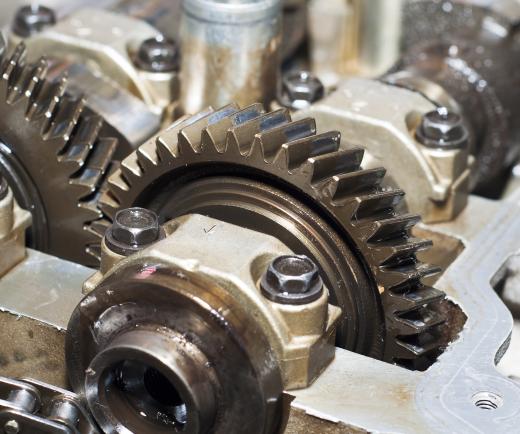A helical gear is a gear with teeth which are set at an angle. The angled teeth teeth engage slowly and smoothly, making a helical gear quieter and smoother in operation than many other kinds of gears. Cars are often equipped with helical gears for this reason, and this design may be used in many other applications, as well. These gears come in a range of sizes for a variety of tasks.
Gears are designed to transfer force, either to other gears or to other objects. They have a distinct mechanical advantage, in that a small gear can be used to turn a larger gear, multiplying the force. Cyclists are well aware of this mechanical advantage, as changing the gear ratio on a bicycle will force a cyclist to do more work, or make a cyclist's job easier. Lower gear ratios, in which the gears are close to the same size, require less energy, but they also generate less rotational motion, while high gear rations force the cyclist to work harder, but create far more rotational force.

When people think of gears, they often think of a spur gear, the classic cog-shaped gear with simple straight teeth. Helical gears are designed in a similar way, except that the teeth run diagonally across the side of the gear, rather than being perpendicularly oriented. The helical gear design has some definite advantages behind smoother and quieter operation caused by the slow intermeshing of helical gears. Helical gears tend to wear down less quickly, because the load of the force is distributed, rather than being concentrated, and the teeth are less subject to chipping.
In addition to interfacing on a parallel level, with the gears side by side, most helical gears can also work perpendicularly to each other when the teeth of the gear are designed correctly. This can be quite a nifty little trick in some instances. The helical gear design does tend to generate a heavy thrust load, a load parallel to the shaft, but this can be compensated for with the use of special bearings.
In a variation on the basic helical gear known as the double helical gear or herringbone gear, the gear has two sets of teeth side by side, slanting at different angles. This reduces the amount of thrust, eliminating the need to use specialized bearings. Herringbone gears may have a v-shaped pattern, or two sets of angled teeth with a groove in the middle, depending on the age of the gears and where they were fabricated. Older fabrication techniques usually required the presence of a trough in the middle of the double helical gear, while newer gears tend to lack this feature.
Ever since she began contributing to the site several years ago, Mary has embraced the exciting challenge of being a About Mechanics researcher and writer. Mary has a liberal arts degree from Goddard College and spends her free time reading, cooking, and exploring the great outdoors.

